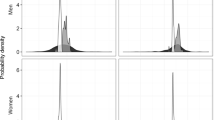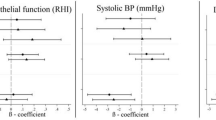Abstract
Epidemiological studies have established an association between outdoor levels of fine particles (PM2.5) and cardiovascular health. However, there is little information on the determinants of PM2.5 exposures among persons with cardiovascular disease, a potentially susceptible population group. Daily outdoor, indoor and personal PM2.5 and absorbance (proxy for elemental carbon) concentrations were measured among elderly subjects with cardiovascular disease in Amsterdam, the Netherlands, and Helsinki, Finland, during the winter and spring of 1998–1999 within the framework of the ULTRA study. There were 37 non-smoking subjects in Amsterdam and 47 in Helsinki. In Amsterdam, where there were enough exposure events for analyses, exposure to environmental tobacco smoke (ETS) indoors was a major source of between-subject variation in PM2.5 exposures, and a strong determinant of PM2.5 and absorbance exposures. When the days with ETS were excluded, within-subject variation accounted for 89% of the total variation in personal PM2.5 and 97% in absorbance in Amsterdam. The respective figures were 66% and 61% in Helsinki. In both cities, outdoor levels of PM2.5 and absorbance were major determinants of personal and indoor levels. Traffic was also an important determinant of absorbance: living near a major street increased exposure by 22%, and every hour spent in a motor vehicle by 13% in Amsterdam. The respective increases were 37% and 9% in Helsinki. Cooking was associated with increased levels of both absorbance and PM2.5. Our results demonstrate that by using questionnaires in connection with outdoor measurements, exposure estimation of PM2.5 and its combustion originating fraction can be improved among elderly persons with compromised health.
This is a preview of subscription content, access via your institution
Access options
Subscribe to this journal
Receive 6 print issues and online access
$259.00 per year
only $43.17 per issue
Buy this article
- Purchase on Springer Link
- Instant access to full article PDF
Prices may be subject to local taxes which are calculated during checkout
Similar content being viewed by others
References
Brunekreef B., Janssen N.A.H., de Hartog J.J., Oldenwening M., Meliefste K., Hoek G., et al. Personal, indoor, and outdoor exposures to PM2.5 and its components for groups of cardiovascular patients in Amsterdam and Helsinki. Res Rep Health Eff Inst 2005: Jan (127): 1–70; discussion 71–79.
Cyrys J., Heinrich J., Hoek G., Meliefste K., Lewne M., Gehring U., et al. Comparison between different traffic-related particle indicators: elemental carbon (EC), PM(2.5) mass, and absorbance. J Expo Anal Environ Epidemiol 2003: 13: 134–143.
Ibald-Mulli A., Timonen K.L., Peters A., Heinrich J., Wolke G., Lanki T., et al. Effects of particulate air pollution on blood pressure and heart rate in subjects with cardiovascular disease: a multi-centre approach. Environ Health Perspect 2004: 112: 369–377.
Ebelt S.T., Petkau A.J., Vedal S., Fisher T. and Brauer M. Exposure of chronic obstructive pulmonary disease patients to particulate matter: relationships between personal and ambient air concentrations. J Air Waste Manage Assoc 2000: 50: 1081–1094.
Ebelt S.T., Wilson W.E., and Brauer M. Exposure to ambient and nonambient components of particulate matter. A comparison of health effects. Epidemiology 2005: 16 (3): 396–405.
Gotschi T., Oglesby L., Mathys P., Monn C., Manalis N., Koistinen K., et al. Comparison of black smoke and PM2.5 levels in indoor and outdoor environments of four European cities. Environ Sci Technol 2002: 36 (6): 1191–1197.
Gray H.A. and Cass G.R. Source contributions to atmospheric fine carbon particle concentrations. Atoms Environ 1998: 32: 3805–3825.
He C., Morawska L., Hitchins J., and Gilbert D. Contribution from indoor sources to particle number and mass concentrations in residential houses. Atmos Environ 2004: 38 (21): 3405–3415.
Hoek G., Brunekreef B., Goldbohm S., Fischer P., and van den Brandt P.A. Association between mortality and indicators of traffic-related air pollution in the Netherlands: a cohort study. Lancet 2002: 360 (9341): 1203–1209.
ISO 9835. 1993 Ambient air — determination of a black smoke index.
Janssen N.A.H., Hoek G., Brunekreef B., and Harssema H. Personal exposure to fine particles in children correlates closely with ambient fine particles. Arch Environ Health 1999: 54: 95–101.
Janssen N.A.H., Hoek G., Brunekreef B., Harssema H., Mensink I., and Zuidhof A. Personal sampling of particles in adults: relation among personal, indoor, and outdoor air concentrations. Am J Epidemiol 1998: 147 (6): 537–547.
Janssen N.A.H., de Hartog J.J., Hoek G., Brunekreef B., Lanki T., Timonen K.L., and Pekkanen J. Personal exposure to fine particulate matter in elderly subjects: relation between personal, indoor, and outdoor concentrations. J Air Waste Manage 2000: 50 (7): 1133–1143.
Janssen N.A.H., Lanki T., Hoek G., Vallius M., de Hartog J.J., Van Grieken R., et al. Associations between ambient, personal, and indoor exposure to fine particulate matter constituents in Dutch and Finnish panels of cardiovascular patients. Occup Environ Med 2005: 62: 868–877.
Jones N.C., Thornton C.A., Mark D., and Harrison R.M. Indoor/outdoor relationships of particulate matter in domestic homes with roadside, urban and rural locations. Atmos Environ 2000: 34: 2603–2612.
Koenig J.Q., Mar T.F., Allen R.W., Jansen K., Lumley T., Sullivan J.H., et al. Pulmonary effects of indoor- and outdoor-generated particles in children with asthma. Environ Health Perspect 2005: 113 (4): 499–503.
Koistinen K.J., Hänninen O., Rotko T., Edwards R.D., Moschandreas D., and Jantunen M.J. Behavioral and environmental determinants of personal exposures to PM2.5 in EXPOLIS — Helsinki, Finland. Atmos Environ 2001: 35 (14): 2473–2481.
Lanki T., Alm S., Ruuskanen J., Janssen N.A.H., Jantunen M., and Pekkanen J. Photometrically measured continuous personal PM2.5 exposure: levels and correlation to a gravimetric method. J Expo Anal Environ Epidemiol 2002: 12: 172–178.
Le Tertre A., Medina S., Samoli E., Forsberg B., Michelozzi P., Boumghar A., et al. Short-term effects of particulate air pollution on cardiovascular diseases in eight European cities. J Epidemiol Commun Health 2002: 56 (10): 773–779.
Lee K., Bartell S.M., and Paek D. Interpersonal and daily variability of personal exposures to nitrogen dioxide and sulfur dioxide. J Expos Anal Environ Epidemiol 2004: 14 (2): 137–143.
Liu L.-J.S., Box M., Kalman D., Kaufman J., Koenig J., Larson T., et al. Exposure assessment of particulate matter for susceptible populations in Seattle. Environ Health Persp 2003: 111 (7): 909–918.
Obot C.J., Morandi M.T., Beebe T.P., Hamilton R.F., and Holian A. Surface components of airborne particulate matter induce macrophage apoptosis through scavenger receptors. Toxicol Appl Pharmacol 2002: 184: 98–106.
Patterson E., and Eatough D. Indoor/outdoor relationships for ambient PM2.5 and associated pollutants: epidemiological implications in Lindon, Utah. J Air Waste Manage Assoc 2000: 50: 103–110.
Peters A., von Klot S., Heier M., Trentinaglia I., Hormann A., Wichmann H.E., and Lowel H. Cooperative Health Research in the Region of Augsburg Study Group. Exposure to traffic and the onset of myocardial infarction. N Engl J Med 2004: 351: 1721–1730.
Pekkanen J., Timonen K.L., Tiittanen P., Vallius M., Lanki T., Sinkko H., et al. ULTRA: Exposure and Risk Assessment for Fine and Ultrafine Particles in Ambient Air. Study Manual and Data Book. Kuopio, Finland: Publications of National Public Health Institute, 2000. Available at http://www.ktl.fi/ultra.
Rojas-Bracho L., Suh H.H., Catalano P.J., and Koutrakis P. Personal exposures to particles and their relationships with personal activities for chronic obstructive pulmonary disease patients living in Boston. J Air Waste Manage Assoc 2004: 54: 207–217.
Rojas-Bracho L., Suh H.H. and Koutrakis P. Relationships among personal, indoor, and outdoor fine and coarse particle concentrations for individuals with COPD. J Expos Anal Environ Epidemiol 2000: 10: 294–306.
Samet J.M., Dominici F., Curriero F.C., Coursac I., and Zeger S.L. Fine particulate air pollution and mortality in 20 US Cities, 1987–1994. N Engl J Med 2000: 343 (24): 1742–1749.
Sørensen M., Loft S., Andersen H.V., Raaschou-Nielsen O., Skovgaard L.T., Knudsen L.E., et al. Personal exposure to PM2.5, black smoke and NO2 in Copenhagen: relationship to bedroom and outdoor concentrations covering seasonal variation. J Expos Anal Environ Epidemiol 2005: 15: 413–422.
von Klot S., Peters A., Aalto P., Bellander T., Berglind N., D'Ippoliti D., et al., for the HEAPSS Study Group Ambient air pollution is associated with increased risk of hospital cardiac readmissions of myocardial infarction survivors in European cities. Circulation 2005: 112: 3073–3079.
Wallace L.A., Mitchell H., O'Connor G.T., Neas L., Lippmann M., Kattan M., et al. Particle concentrations in inner-city homes of children with asthma: the effect of smoking, cooking, and outdoor pollution. Environ Health Persp 2003: 111 (9): 1265–1272.
Wichmann J., Janssen N.A.H., van der Zee S., and Brunekreef B. Traffic-related differences in indoor and personal absorption coefficient measurements in Amsterdam, the Netherlands. Atmos Environ 2005: 39: 7384–7392.
Özkaynak H., Xue J., Spengler J., Wallace L., Pellizzari E., and Jenkins P. Personal exposure to airborne particles and metals: results from the particle team study in Riverside, California. J Expos Anal Environ Epidemiol 1996: 6 (1): 57–78.
Acknowledgements
We acknowledge the assistance of M.Sc. Pekka Tiittanen (National Public Health Institute (KTL)) with statistical analyses. Research described in this article was conducted under contract (research agreement #98-16) to the Health Effects Institute (HEI), an organization jointly funded by the United States Environmental Protection Agency (EPA) (Assistance agreement R82811201) and automotive manufacturers. The contents of this article do not necessarily reflect the views of HEI nor do they necessarily reflect the views and policies of EPA, or motor vehicle and engine manufacturers. The research project was conducted within the framework of the ULTRA study (EU contract ENV4-CT97-0568). The study was also funded by the Academy of Finland (research agreements #102345 and #42625) and National Public Health Institute.
Author information
Authors and Affiliations
Corresponding author
Rights and permissions
About this article
Cite this article
Lanki, T., Ahokas, A., Alm, S. et al. Determinants of personal and indoor PM2.5 and absorbance among elderly subjects with coronary heart disease. J Expo Sci Environ Epidemiol 17, 124–133 (2007). https://doi.org/10.1038/sj.jes.7500470
Received:
Accepted:
Published:
Issue Date:
DOI: https://doi.org/10.1038/sj.jes.7500470
Keywords
This article is cited by
-
Indoor air pollutant exposure and determinant factors controlling household air quality for elderly people in Hong Kong
Air Quality, Atmosphere & Health (2018)
-
Internal dose of particles in the elderly—modeling based on aerosol measurements
Environmental Science and Pollution Research (2018)
-
Risk assessment of inhalation exposure to polycyclic aromatic hydrocarbons in school children
Environmental Science and Pollution Research (2014)
-
An indoor air filtration study in homes of elderly: cardiovascular and respiratory effects of exposure to particulate matter
Environmental Health (2013)
-
Variability of environmental exposure to fine particles, black smoke, and trace elements among a Swedish population
Journal of Exposure Science & Environmental Epidemiology (2011)



